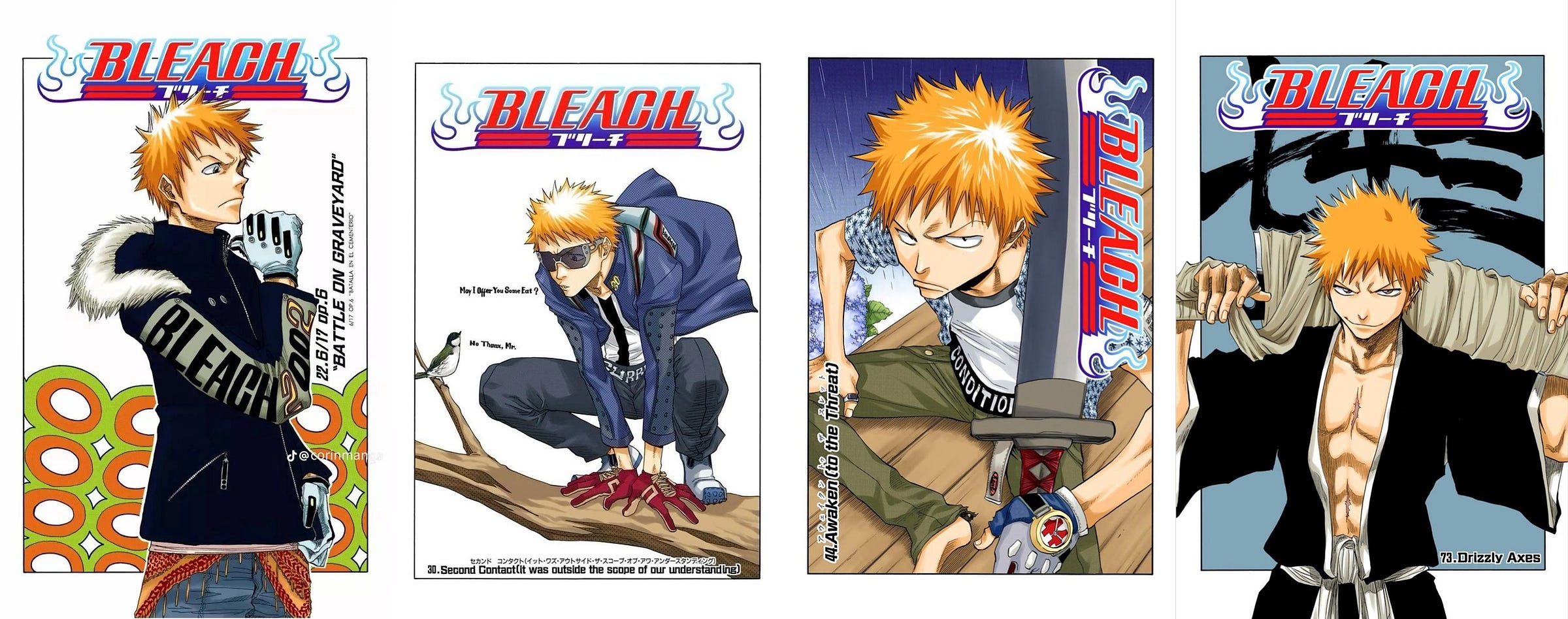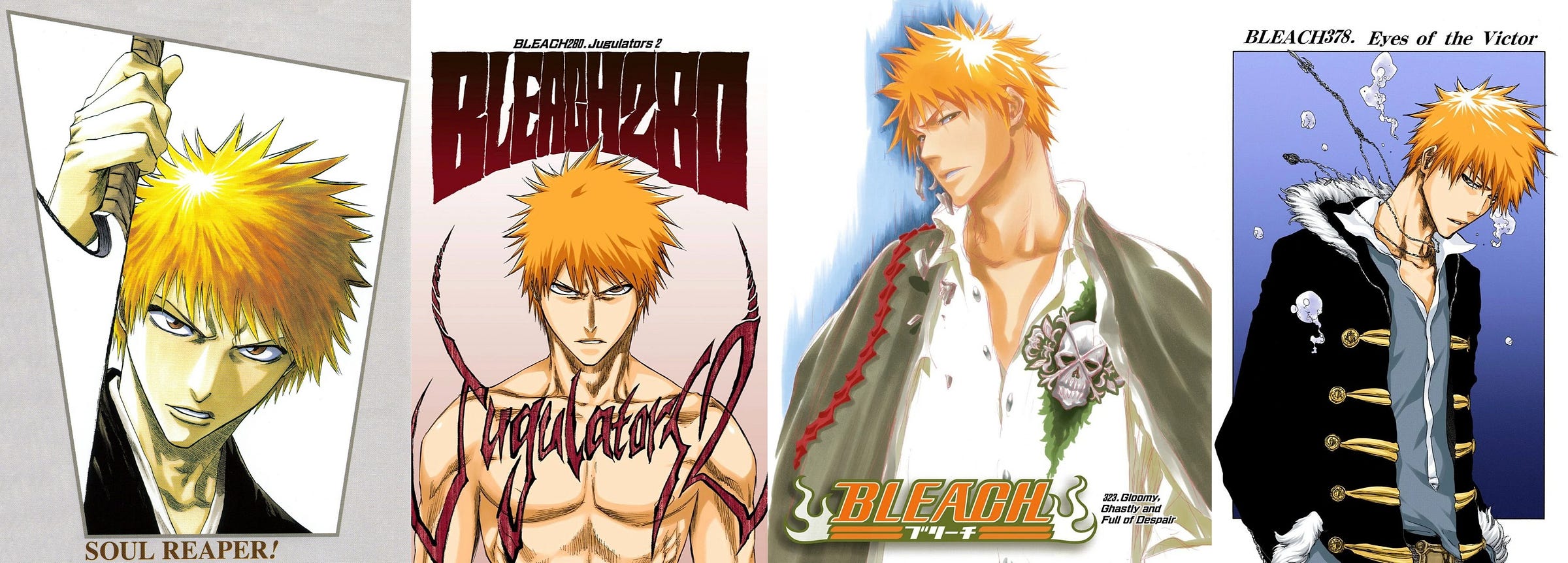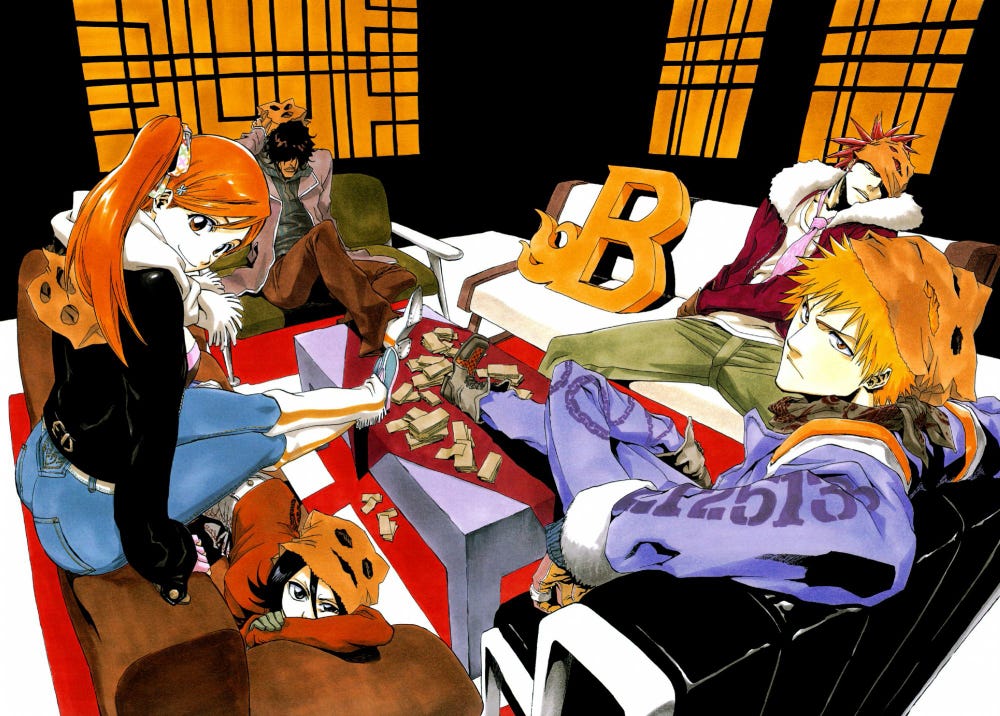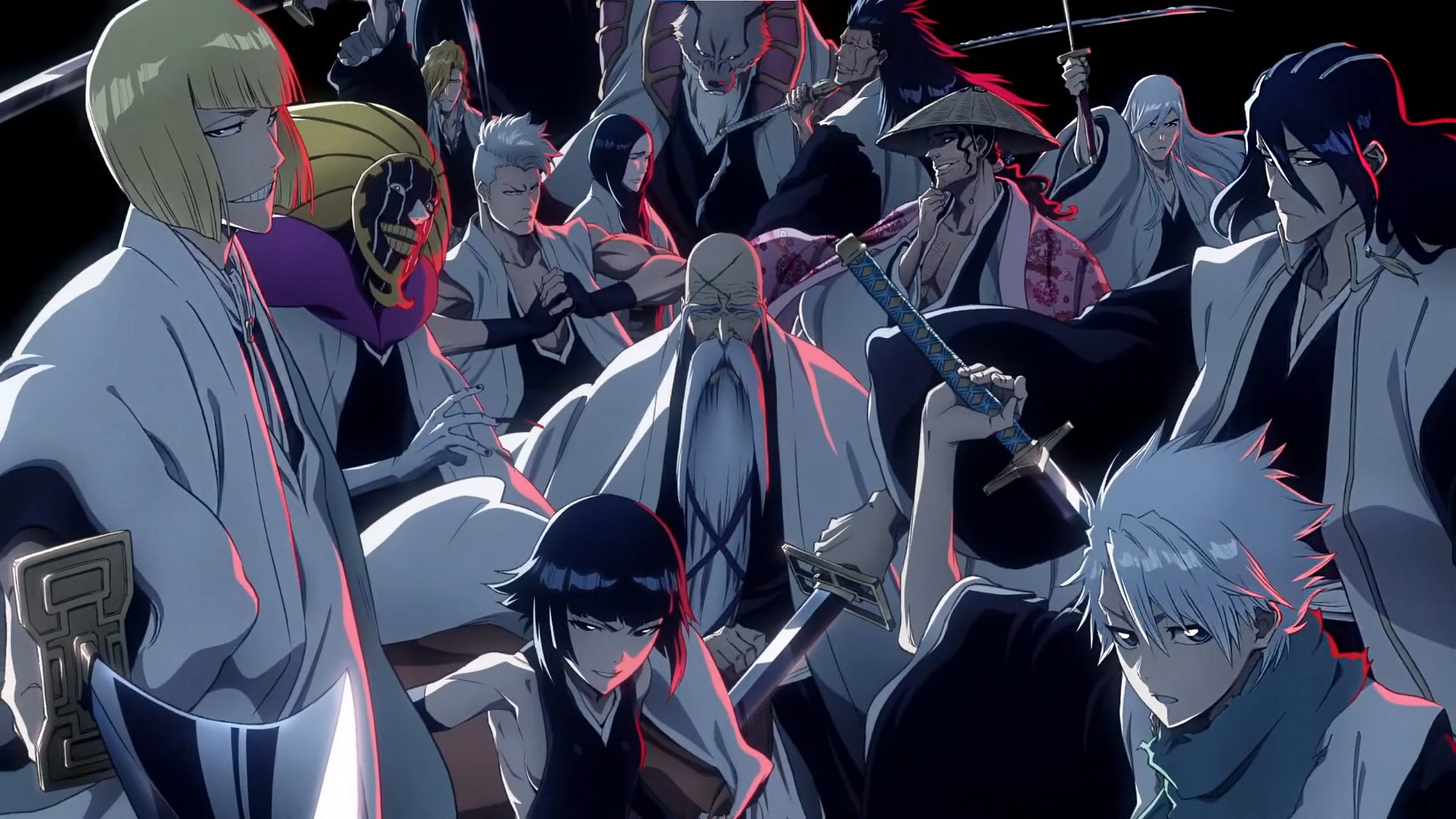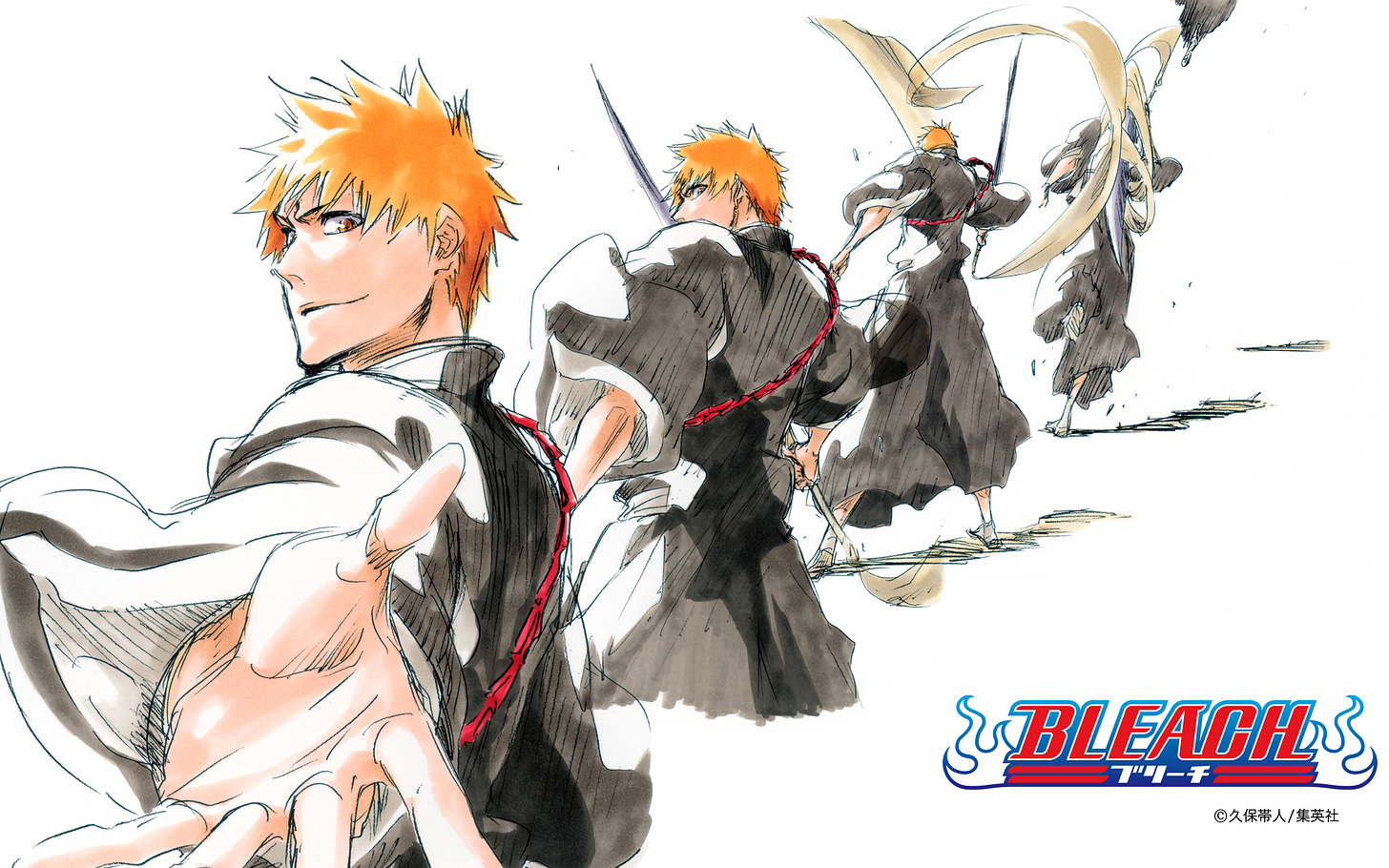An Ode To: BLEACH
As the latest season of the critically acclaimed Thousand-Year Blood War arc comes to a dramatic end, I want to share my thoughts on this series overall and what it means to me.
Synopsis
Ichigo Kurosaki is a teenager who can see ghosts, a talent allowing him to meet Rukia Kuchiki, a Soul Reaper who enters his town to lead ghosts into the afterlife and to kill Hollows, a monstrous lost soul who can harm both ghosts and humans. Soul Reapers are trusted with ushering the souls of the dead from the World of the Living to the Soul Society, the afterlife realm from which she originates from, or to cast them to Hell. When she is severely wounded defending Ichigo from a Hollow, Rukia transfers her powers to him, so he may fight in her stead while she recovers. As she’s trapped in the The World Of The Living, she must advise Ichigo as he balances the demands of his substitute Soul Reaper duties and attending high school.

Introduction
“An Ode To” is a series of posts that I am developing as an excuse to gush about something meaningful to me. It could be about a series, a writer or even a concept. I want to introduce the subject as best as I can to those alien to it, while also referencing why I love said subject. My hiatus here has been going on for a while. I have a lot more stuff planned for 2025, which includes finishing my current ‘Fight & Flight’ project, but I’ve decided to end 2024 with this piece, as the latest season of Bleach is headed full pelt to its finale. I decided to embed several pieces of media today, with special focus on the animation, art and music. I’ve made sure to come out swinging here, this series deserves it.
Here’s a short preview from the first episode. It will also be the only clip with sound, as the others will be focused on the animation. All rights reserved to Tite Kubo, Shueisha, Viz Media, TV Tokyo & Studio Pierrot.
This is a series that I have followed for around 15 years, and as of writing this, is due to finish its third season or cour(a word used to describe a span of anime episodes during their initial Japanese TV broadcast) of the highly acclaimed ‘Thousand-Year Blood War’(TYBW) arc later today. It has been a journey. Starting off as a simple ghost story and then descending deep into the horror genre, with mysterious elements, and then it transforms again. This is also backed by a soundtrack which oozes ominous creativity. The Soul Society arc is still considered one of the best in the genre. There’s also the character designs, particularly the fashion which imbues a different kind of aura, leading to the villains to be especially unorthodox. The supporting cast in Bleach are for the most part well fleshed out, in the Soul Society arc, we meet the Gotei 13, otherwise known as the 13th Court Guard Squads. 13 squads, 13 captains, each who are vastly different than the next. It is thoroughly impressive how the series continues to produce ensembles, as seen in the Arrancar and TYBW arcs.
The current adaptation is a sequel series to the original anime, which ran from October 5, 2004 until March 27, 2012. The third cour of the TYBW started premiere on the 20th anniversary of the anime to the exact date, October 5, 2024. I would obviously recommend watching the original series from the beginning, especially since you can skip the filler in the series. For reference, “filler” refers to the anime only episodes in a series that are not canon to the source material. These are usually used when the anime catches up to the manga, which tends to happen for long running shows like Bleach. Sometimes they can be fun side stories, awful, or even seasons in of themselves, all three have been the case for Bleach. Nevertheless, it is certainly worth the effort.
The Animation
I’ve provided a set number of clips from the Original 2004 adaptation and the TYBW arc.
Original 2004 Adaptation Animation
These clips, in 1:1 aspect ratio, in spite of being dated, the art, animation and direction, are thoroughly exceptional.
Two segments from separate opening credits of the original 2004 adaptation, now in the widescreen ratio, as Bleach aired during the transition.
TYBW Arc Animation
From ‘Bleach Thousand-Year Blood War’ Anime, examples of the high quality from the new adaptation.
There’s not a better display of passion and longevity than Tsuguyuki Kubo, who has worked as an animator in the industry for at least 58 years.
The Correlation of Art & Character Development
I also want to focus on the source material, the manga, drawn and written by Tite Kubo. Since Bleach’s serialization in Weekly Shonen Jump in 2002, the artwork slowly goes through a much more drastic shift than many of its counterparts. Early on, Bleach appears to have a specific mystique, with an obvious punk vibe, exemplified by the main character. Over time, he becomes more conventionally handsome, as his own mindset begins to change from a stoic but angry teenager, to someone who is motivated to protect his world from the threats it faces. At the start, Ichigo repeatably states that he does things on his own terms and doesn’t want the responsibility of helping others, things begin to change when he’s driven to not only accept that responsibility but to fight for it. In doing so, his metamorphosis from angst, and reluctancy evolves into pride and accomplishment. And there’s no better form of showing that than Kubo’s artwork.
As the series matures, so does its main character, one runs parallel with another, and is of course directly connected to the author himself simply becoming a better artist. He bestows us with some quality artwork, as well as some dapper original fashion. Kubo has gone on record stating that he draws clothes in his manga that he can’t find elsewhere, his series lends itself as another manifestation of his own personal thoughts. Looking back, we see a boy who’s simply drifting day by day, with no particular lofty ambition or goals, to a man with an unbreakable resolve. There’s nothing more powerful than an expression and Ichigo pointing his sword directly to the viewer in the image above is as commanding as it gets. There’s nothing more impressive than someone who exudes confidence and charisma. A feat which he earns, through tireless effort and suffering, much like Tite Kubo.
Delving Deeper
Bleach has vast world building, which can almost be a detriment given how much you would need to write, with obvious inspirations from religious symbolism such as Buddhism, Hinduism and Shintoism. For instance, ‘The Wheel of Life’ is a core concept in Buddhism, depicting the circle of life and rebirth. This is not only depicted in Bleach but is an overarching plot detail and structurally important to the world in this series. If the balance of life and death were to be disrupted, it would eventually lead all of the realms to cease. Speaking of which, Buddhism has 6 planes of existence; Deva (Gods), Asura (Demigods), Humans, Animals, Preta (Hungry Spirits), and Naraka (Hell). Within Bleach, these are named: Soul King's Palace, Sword Spirit Dimension, Soul Society, The World Of The Living, Hueco Mundo, and Jikoku (Hell). Bleach combines at the time modern Japanese society in conjunction with its own interpretation of the afterlife, and expands on it to an impressive degree. On a personal note, I found this ridiculously fascinating and I still want to see more of the overall world. To no surprise, this series has been a huge inspiration for the likes of modern popular anime such as Demon Slayer and Jujutsu Kaisen. Bleach shows its craft in the most auspicious way.
What makes it so different?
We begin to pick up that through foreshadowing and reveals, this was always where the series was headed, making it appear more planned than we initially thought. This coupled with the high octane action that has become so synonymous with the franchise. Of course, this series had a modicum of talent working conjunctly with one another to flesh out the passion that the author uniquely produces, as you’ve seen in the uploaded clips. Then there’s the scintillating music composed by Shiro Sagisu, this allows Bleach to feel more ceremonious than its counterparts. For example, Ichigo’s soundtrack is entitled ‘Number One’, which is sung by Hazel Fernandes, a British house music artist, who is known to collaborate with Sagisu in other projects too. This track feels more akin to soul music than the traditional themes you’d hear in anime, complete with English lyrics. There’s also the influence of the author, who not only listens to music when he draws the manga, but also assigned characters with a theme song. Kubo’s influence is at its peak right now, as he is working directly with the animation staff, and it’s evident with how beautifully enriched the anime has become, building on his original framework with unreal tenacity. Circling back to the musical themes, there are a wide variety on display, in both the original anime, and the TYBW, which recently released the 2nd cour’s soundtrack.
The Original Soundtrack
Sit back and listen to a handful of soundtracks that I’ve compiled which epitomise this series.
Bleach OST: On the Precipice of Defeat
Bleach OST: Creeping Shadows
Bleach OST: Number One(Vocal Version)
Bleach TYBW OST: On The Precipice - Post Grunge
Bleach TYBW OST: Racy Orchestra
Bleach TYBW Cour 2 OST: Torn Apart Heavy Metal
Personal Retrospective
Ever since I started this show, I became enamoured with how different it was to anything I had watched at the time. Eventually, I had caught up to the anime around 2 years before it ended, and had picked up the manga when the series inevitably started another filler arc. When the anime finally ended, it was bittersweet and with Bleach’s popularity slowly dwindling, it was anyone’s guess when it would return. Fortunately, the TYBW arc began with breakneck pace and made some very bold decisions, most of which were very well received in spite of how unpopular it might have been, thanks to the quality of the work. While this gave optimism about an eventual return to animation, this started to diminish when the cracks began to appear. During the climax, the series’ pacing took a progressive nosedive as did the quality, and out of seemingly nowhere, the ending of the series was confirmed via a volume release in Japan. It had later been revealed that the author was suffering from an injury and could not continue the series. Leading to one of the most unsatisfying mainstream manga endings, marred with wasted potential. This was more than 8 years ago, and since the announcement of the anime sequel, the tide began to turn.
Comeback Story For The Ages
Without a shadow of a doubt, I knew this adaptation would blow my expectations out of the water as soon as the first trailer dropped, it was beautiful. These characters looked almost unrecognizable, their animation and character designs were not only updated to modern standards, but they are now the standard. The fluidity of the animation, the gorgeously drawn artwork and the immaculate storyboarding surpasses most, if not all anime that are currently airing. The production made incredible decisions regarding rewriting, reworking and retooling certain aspects of the manga that made it flow subsequently better from the very first episodes. These tweaks are not as noticeable at first, but as the adaptation goes on, in particular with this 3rd cour, they have added completely new material and managed to gently pace such a chaotic section of the source material. This production is filled with high quality talent, whose record in the industry is synonymous with world class calibre, Pierrot Films have assembled an unbeatable team here. Manga readers like me may deduce where this arc ends, but we are truly in the dark as to what is going to happen in the final cour. It’s possible that the ending we originally got is going to change too. The ‘Conflict’ cour is not only the most well received out of all the TYBW cours but it has to be one of the most critically acclaimed anime seasons.
My Conclusion
You are not just missing out on Bleach if you are fan of anime, you are missing out on Bleach if you simply appreciate storytelling, music, direction, everything that makes a story function superfluously, you are robbing yourself of a series that is as breath-taking as it is seemingly overwhelming to start. I wouldn’t consider this series a marathon or an uphill climb to finish, but an all you can eat buffet. It is all there for you to gorge, with just a final cour remaining. By the time you catch up, it might already be airing. So there you have it, that is my ode to a series which has had a deep and meaningful impact on not just me specifically, but many people who I’m sure have become even more invested and appreciative of the media.






